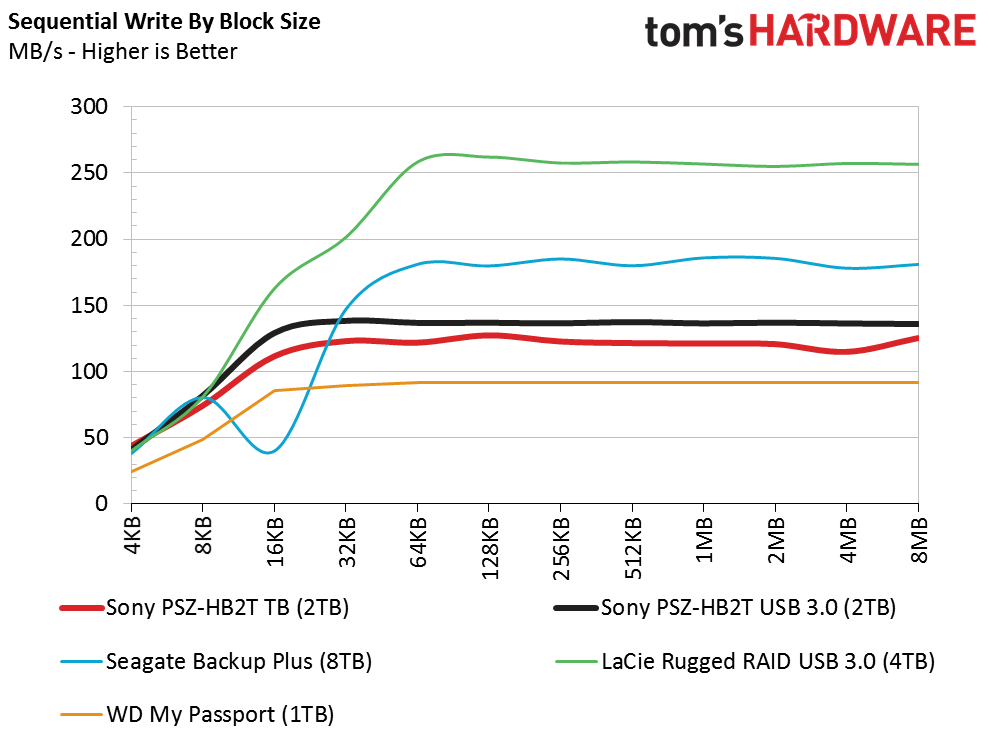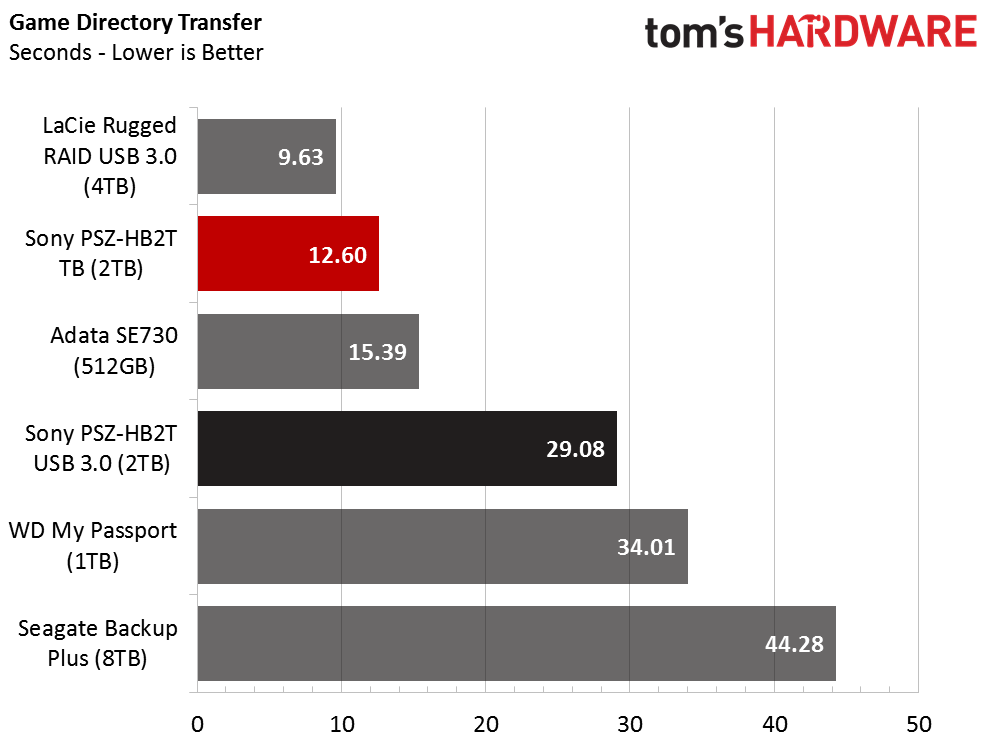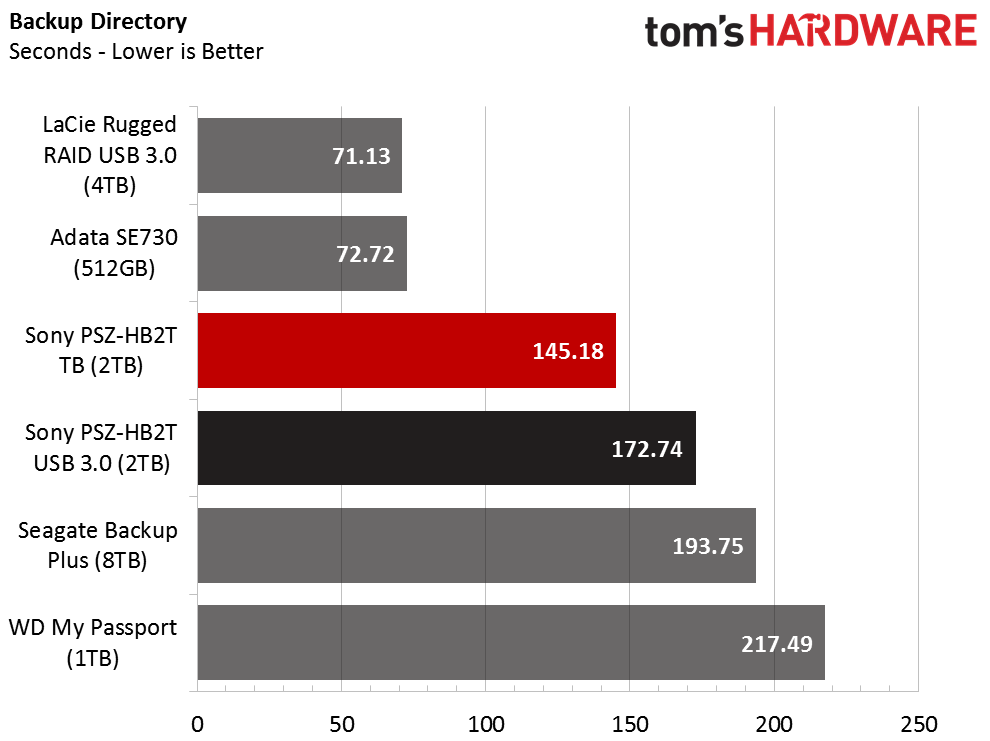Sony PSZ-HB2T External Rugged HDD Review
Sony has a new line of portable, rugged storage products to complement the company's professional imaging products. Today, we look at a 2TB single-drive model designed to go where traditional storage cannot.
Why you can trust Tom's Hardware
Performance Testing And Conclusion
Sequential Scaling Block Sizes


To start our testing, we look at sequential reads and writes according to block sizes. Some products are tuned to deliver higher performance depending on the type of data being transferred. But most of the tuning happens with solid-state storage, rather than mechanical disks.
We tested the PSZ-HB2T with both USB 3.0 and Thunderbolt connections. Surprisingly, USB 3.0 delivered higher performance than Thunderbolt when it came to sequential transfers.
Full LBA Span Performance


Now we're reading and writing across the entire user logical block addressing range of the drives. Hard disks read and write faster along the outer portion of their platters, and lose performance as more data occupies the drive. This test allows us to isolate the maximum and minimum transfer rates.
In our test with 128KB blocks, Sony's PSZ-HB2T delivered 131 MB/s on the outer tracks, 95 MB/s in the middle and just 54 MB/s on the inner tracks. It should also be noted that you get more consistent performance with USB 3.0 than Thunderbolt.
File Transfers



Rounding out our external storage performance test are simple file transfers to the unit we're evaluating. We use Disk Bench to measure the results in both throughput and time. Time, it turns out, is a better measurement for displaying results because everyone can relate to it. We also added Adata's SE730—a flash-based external storage model—to the results.
When working with large-block data moved sequentially, the PSZ-HB2T's USB 3.0 port is fastest. When we shifted over to mixed data, the Thunderbolt connection took the lead. Thunderbolt can handle small file transfers better than USB, so this didn't surprise us. The Game Directory Transfer Test (using rFactor) consists of almost all small files, and really shows the difference in interface connection speeds.
Conclusion
As media files continue to get larger, the need for high-capacity portable storage also increases. The transition to 4K video is happening swiftly, putting more emphasis on speed and size. Sony's latest external storage model can sustain high bit rate 4K transfers for half of the drive's capacity, but not across the full user LBA range. This could be an issue for professionals using the disk as a direct-attached target, and it'll likely strain a camera's buffering system. In my experience, once the buffer fills, the camera drops frames to ease the load. However, I've admittedly never used a full professional 4K system designed to deliver broadcast-quality video. I have used professional-grade 1080p devices that record at 60 frames per second, so I'm one generation behind the curve.
Get Tom's Hardware's best news and in-depth reviews, straight to your inbox.
As an external backup storage device, Sony's PSZ-HB2T is an average solution once you factor out its enhanced durability features. It's essentially a low-cost 2.5-inch hard drive inside a fancy case that you can drop from waist-level heights.
Then again, there are very few ruggedized external storage products on the market that aren't SSD-based. Sony's biggest competitor is probably LaCie, and that company's Rugged Thunderbolt is a direct competitor (LAC9000489 2TB model at $270 MSRP) to the product we tested today. Unfortunately for Sony, it fails to hit a more attractive price point. Surely that won't come as a surprise to anyone who has compared the prices of Sony consumer electronics to those of other manufacturers.
All of these types of products tend to cost significantly more than their non-rugged counterparts. Who knew rubber and foam were so expensive?
MORE: How We Test HDDs And SSDsMORE: All Storage Content
MORE: Latest Storage News
MORE: Storage in the Forums
Chris Ramseyer is a Contributing Editor for Tom's Hardware, covering Storage. Follow him on Twitter and Facebook.
Follow us on Facebook, Google+, RSS, Twitter and YouTube.
- 1
- 2
Current page: Performance Testing And Conclusion
Prev Page Specifications, Pricing, Warranty & Accessories
Chris Ramseyer was a senior contributing editor for Tom's Hardware. He tested and reviewed consumer storage.
-
Onus ReplyInner-track sequential write performance is lower than what Sony's professional 4K video models can send to external storage.
Wouldn't that be an absolute dealbreaker, particularly in the pro market?